Dynamic Response Study of Space Large-Span Structure under Stochastic Crowd-Loading Excitation
Abstract
:1. Introduction
2. Stochastic Crowd-Loading Model
2.1. Stochastic Pedestrian Walking Loads
2.2. Stochastic Pedestrian Walking Routes
2.2.1. Stochastic Pedestrian Walking Route Influences Factor
- (1)
- Environmental factors: mainly include the spatial structure of the building, exit, walls, and other scene factors, as well as crowd distribution, density, and other crowd factors.
- (2)
- Accidental factors: describe the impact of accidental hazards on behavioral decisions such as fire and smoke.
- (3)
- Pedestrian characteristics: describe the effects of pedestrian movement characteristics (e.g., acceleration, steering, forward and right-side walking preferences), behavioral characteristics (e.g., agitation, fear, and aggression), and experiential factors (e.g., familiarity) on behavioral decisions.
- (4)
- Pedestrian interaction: describes the influence of interaction and information exchange between pedestrians on behavioral decisions.
2.2.2. The Floor Field Cellular Automata
The Static Floor Field
The Dynamic Floor Field
2.2.3. The Behaviorally Oriented Floor Field Cellular Automata
2.2.4. State Update Rules
- (a)
- The initial pedestrian spatial distribution states are randomly selected from the set of possible initial pedestrian spatial distribution states.
- (b)
- Calculate the selection probability of the walking direction for each walker at each time based on Equations (6)–(8).
- (c)
- Equation (9) is used to calculate the stride speed of the pedestrians in the corresponding time step.
- (d)
- The pedestrian’s walking behavior is described according to Equation (10), and the real coordinates of the traveler at the next time step are calculated.
- (e)
- Transforms pedestrian real coordinate positions to integer cellular positions.
- (f)
- Update the time step and loop rules (b)–(e).
2.3. Development and Application of a Walking Load Database for Stochastic Crowds
3. Validation of Stochastic Crowd-Loading Model
3.1. Dynamic Characterization of Space Large-Span Structure
3.1.1. Dynamic Characterization Tests of Space Large-Span Structure
3.1.2. Finite Element Modal Analysis of Space Large-Span Structure
3.2. Finite Element Computational Validation of Stochastic Crowd-Loading Model
3.2.1. Human-Induced Vibration Testing of Space Large-Span Structure
3.2.2. Finite Element Accuracy Verification of Stochastic Crowd-Loading Model
4. Vibration Suitability Assessment of Space Large-Span Structure
5. Influence of Stochastic Crowd-Loading Model Parameters on Structural Dynamic Response
5.1. Influence of Walking Parameters on Structural Dynamic Response
5.2. Influence of Pedestrian Dynamic Behavior on Structural Dynamic Response
5.3. Influence of Crowd Density on Structural Dynamic Response
6. Conclusions
Author Contributions
Funding
Data Availability Statement
Conflicts of Interest
References
- Dallard, P.; Fitzpatrick, A.; Flint, A.; Le Bourva, S.; Low, A.; Ridsdill Smith, R.M.; Willford, M. The London Millennium Footbridge. Struct. Eng. 2001, 79, 17–33. [Google Scholar]
- Rönnquist, A.; Strømmen, E.; Wollebæk, L. Dynamic Properties from Full Scale Recordings and FE-Modelling of a Slender Footbridge with Flexible Connections. Struct. Eng. Int. 2008, 18, 421–426. [Google Scholar] [CrossRef]
- Basaglia, B.M.; Li, J.; Shrestha, R.; Crews, K. Response Prediction to Walking-Induced Vibrations of a Long-Span Timber Floor. J. Struct. Eng. 2021, 147, 04020326. [Google Scholar] [CrossRef]
- Chen, Z.; Chen, Z.; Li, G.; Zhang, W.; Zhang, X.; Huang, S.; Chen, Z. Dynamic Response Analysis and Vibration Reduction of Steel Truss Corridor Pedestrian Bridge under Pedestrian Load. Front. Mater. 2022, 9, 839265. [Google Scholar] [CrossRef]
- Cao, L.; Liu, J.; Zhou, X.; Chen, Y.F. Vibration Performance Characteristics of a Long-Span and Light-Weight Concrete Floor under Human-Induced Loads. Struct. Eng. Mech. 2018, 65, 349–357. [Google Scholar] [CrossRef]
- Jiang, L.; Cheng, R.; Zhang, H.; Ma, K. Human-Induced-Vibration Response Analysis and Comfort Evaluation Method of Large-Span Steel Vierendeel Sandwich Plate. Buildings 2022, 12, 1228. [Google Scholar] [CrossRef]
- Živanović, S.; Pavić, A.; Reynolds, P. Probability-Based Prediction of Multi-Mode Vibration Response to Walking Excitation. Eng. Struct. 2007, 29, 942–954. [Google Scholar] [CrossRef]
- Kerr, S.C.; Bishop, N.W.M. Human Induced Loading on Flexible Staircases. Eng. Struct. 2001, 23, 37–45. [Google Scholar] [CrossRef]
- Racic, V.; Brownjohn, J.M.W. Stochastic Model of Near-Periodic Vertical Loads Due to Humans Walking. Adv. Eng. Inform. 2011, 25, 259–275. [Google Scholar] [CrossRef]
- Chen, J.; Peng, Y.X.; Wang, L. Experimental investigation and mathematical modeling of single footfall load using motion capture technology. China Civ. Eng. J. 2014, 47, 79–87. [Google Scholar] [CrossRef]
- Chen, J.; Ding, G.; Živanović, S. Stochastic Single Footfall Trace Model for Pedestrian Walking Load. Int. J. Struct. Stab. Dyn. 2019, 19, 1950029. [Google Scholar] [CrossRef]
- Chen, J.; Wang, H.Q.; Peng, Y.X. Experimental investigation on Fourier-series model of walking load and its coefficients. J. Vib. Shock 2014, 33, 11–15+28. [Google Scholar] [CrossRef]
- Cao, L.L.; Li, A.Q.; Zhang, Z.Q.; Zhou, D.L.; Zhou, C.Y. Human-Induced Vibration Analysis and Measurement of Long-Span Composite Floors. J. Southwest Jiaotong Univ. 2012, 47, 922–928. [Google Scholar] [CrossRef]
- Tang, L.P.; Xie, W.P.; He, W.; Zhang, T. Vibration response characteristics analysis of long-span composite floor under crowd loads. Build. Sci. 2017, 33, 85–90. [Google Scholar] [CrossRef]
- Piccardo, G.; Tubino, F. Equivalent Spectral Model and Maximum Dynamic Response for the Serviceability Analysis of Footbridges. Eng. Struct. 2012, 40, 445–456. [Google Scholar] [CrossRef]
- Ferrarotti, A.; Tubino, F. Generalized Equivalent Spectral Model for Serviceability Analysis of Footbridges. J. Bridge Eng. 2016, 21, 04016091. [Google Scholar] [CrossRef]
- Li, H.; Jian, F.L. Human-induced structural vibrations under crowd walking loads. J. South China Univ. Technol. (Nat. Sci. Ed.) 2010, 38, 125–130. [Google Scholar] [CrossRef]
- Yang, N.; Qiu, X. Crowd density load model and analysis of crowd-induced vibration. J. Beijing Jiaotong Univ. 2016, 40, 88–96. [Google Scholar] [CrossRef]
- Da Silva, F.T.; Brito, H.M.B.F.; Pimentel, R.L. Modeling of Crowd Load in Vertical Direction Using Biodynamic Model for Pedestrians Crossing Footbridges. Can. J. Civ. Eng. 2013, 40, 1196–1204. [Google Scholar] [CrossRef]
- Gazzola, F.; Racic, V. A Model of Synchronisation in Crowd Dynamics. Appl. Math. Model. 2018, 59, 305–318. [Google Scholar] [CrossRef]
- Wang, J.; Chen, J.; Yokoyama, Y.; Xiong, J. Spectral Model for Crowd Walking Load. J. Struct. Eng. 2020, 146, 04019220. [Google Scholar] [CrossRef]
- Li, Y.; He, X.; Zhou, C. Automatic Modulation Recognition Based on a New Deep K-SVD Denoising Algorithm. J. Data Sci. Intell. Syst. 2023. online first. [Google Scholar] [CrossRef]
- Fan, Q.; Jiang, M.; Huang, W.; Jiang, Q. Considering Spatiotemporal Evolutionary Information in Dynamic Multi-objective Optimisation. CAAI Trans. Intell. Technol. 2023. online version of record. [Google Scholar] [CrossRef]
- Mustapha, S.; Kassir, A.; Hassoun, K.; Dawy, Z.; Abi-Rached, H. Estimation of Crowd Flow and Load on Pedestrian Bridges Using Machine Learning with Sensor Fusion. Autom. Constr. 2020, 112, 103092. [Google Scholar] [CrossRef]
- Su, D.; Stanimirović, P.S.; Han, L.B.; Jin, L. Neural Dynamics for Improving Optimiser in Deep Learning with Noise Considered. CAAI Trans. Intell. Technol. 2023. online version of record. [Google Scholar] [CrossRef]
- Li, Y.; Chen, M.; Dou, Z.; Zheng, X.; Cheng, Y.; Mebarki, A. A Review of Cellular Automata Models for Crowd Evacuation. Phys. A Stat. Mech. Its Appl. 2019, 526, 120752. [Google Scholar] [CrossRef]
- Yu, R.; Mao, Q.; Lv, J. An Extended Model for Crowd Evacuation Considering Rescue Behavior. Phys. A Stat. Mech. Its Appl. 2022, 605, 127989. [Google Scholar] [CrossRef]
- Zhao, R.; Zhai, Y.; Qu, L.; Wang, R.; Huang, Y.; Dong, Q. A Continuous Floor Field Cellular Automata Model with Interaction Area for Crowd Evacuation. Phys. A Stat. Mech. Its Appl. 2021, 575, 126049. [Google Scholar] [CrossRef]
- Xue, S.; Claudio, F.; Shi, X.; Li, T. Revealing the Hidden Rules of Bidirectional Pedestrian Flow Based on an Improved Floor Field Cellular Automata Model. Simul. Model. Pract. Theory 2020, 100, 102044. [Google Scholar] [CrossRef]
- Lu, L.; Chan, C.-Y.; Wang, J.; Wang, W. A Study of Pedestrian Group Behaviors in Crowd Evacuation Based on an Extended Floor Field Cellular Automaton Model. Transp. Res. Part C Emerg. Technol. 2017, 81, 317–329. [Google Scholar] [CrossRef]
- Guo, R.; Ren, Y.; Wang, S.X.; Pan, Y. A study on stochastic crowd load model based on crowd density. J. Vib. Shock 2021, 40, 255–263+270. [Google Scholar] [CrossRef]
- Štěpánek, J.; Máca, J. Relation between Stationary and Moving Pedestrian Load Models. Acta Polytech. CTU Proc. 2018, 15, 114–119. [Google Scholar] [CrossRef]
- Li, X.; Wu, J.; Li, X. Theory of Practical Cellular Automaton; Springer: Singapore, 2018; ISBN 978-981-10-7496-7. [Google Scholar]
- Guo, R.-Y. New Insights into Discretization Effects in Cellular Automata Models for Pedestrian Evacuation. Phys. A Stat. Mech. Its Appl. 2014, 400, 1–11. [Google Scholar] [CrossRef]
- Zheng, Y.; Jia, B.; Li, X.-G.; Jiang, R. Evacuation Dynamics Considering Pedestrians’ Movement Behavior Change with Fire and Smoke Spreading. Saf. Sci. 2017, 92, 180–189. [Google Scholar] [CrossRef]
- Guan, J.; Wang, K.; Chen, F. A Cellular Automaton Model for Evacuation Flow Using Game Theory. Phys. A Stat. Mech. Its Appl. 2016, 461, 655–661. [Google Scholar] [CrossRef]
- Hrabák, P.; Bukáček, M. Influence of Agents Heterogeneity in Cellular Model of Evacuation. J. Comput. Sci. 2017, 21, 486–493. [Google Scholar] [CrossRef]
- Li, D.; Han, B. Behavioral Effect on Pedestrian Evacuation Simulation Using Cellular Automata. Saf. Sci. 2015, 80, 41–55. [Google Scholar] [CrossRef]
- Wang, X.; Guo, W.; Zheng, X. Information Guiding Effect of Evacuation Assistants in a Two-Channel Segregation Process Using Multi-Information Communication Field Model. Saf. Sci. 2016, 88, 16–25. [Google Scholar] [CrossRef]
- Huang, R.; Zhao, X.; Zhou, C.; Kong, L.; Liu, C.; Yu, Q. Static Floor Field Construction and Fine Discrete Cellular Automaton Model: Algorithms, Simulations and Insights. Phys. A Stat. Mech. Its Appl. 2022, 606, 128150. [Google Scholar] [CrossRef]
- GB50010-2010; Code for Design of Concrete Structures. China Construction Industry Press: Beijing, China, 2010.
- Schlaich, M.; Brownlie, K.; Cozett, J.; Sobrino, J.; Strasky, J.; Takenouchi, K. Fib Bulletin 32. Guidelines for the Design of Footbridges; fib. The International Federation for Structural Concrete, Ed.; fib Bulletins; fib. The International Federation for Structural Concrete: Lausanne, Switzerland, 2005; ISBN 978-2-88394-072-7. [Google Scholar]
- JGJ99-2015; Technical Specification for Steel Structure of Tall Building. Ministry of Housing and Urban-Rural Development of the People’s Republic of China. China Architecture & Building Press: Beijing, China, 2016.
- JGJ/T441-2019; Technical Standard for Human Comfort of the Floor Vibration. China Architecture & Building Press: Beijing, China, 2019.
- HiVoSS. Human Induced Vibrations of Steel Structures: Design of Footbridges; RFS2-CT-2007-00033, Footbridge_Guidelines_EN03; European Communities: Luxembourg, 2008. [Google Scholar]
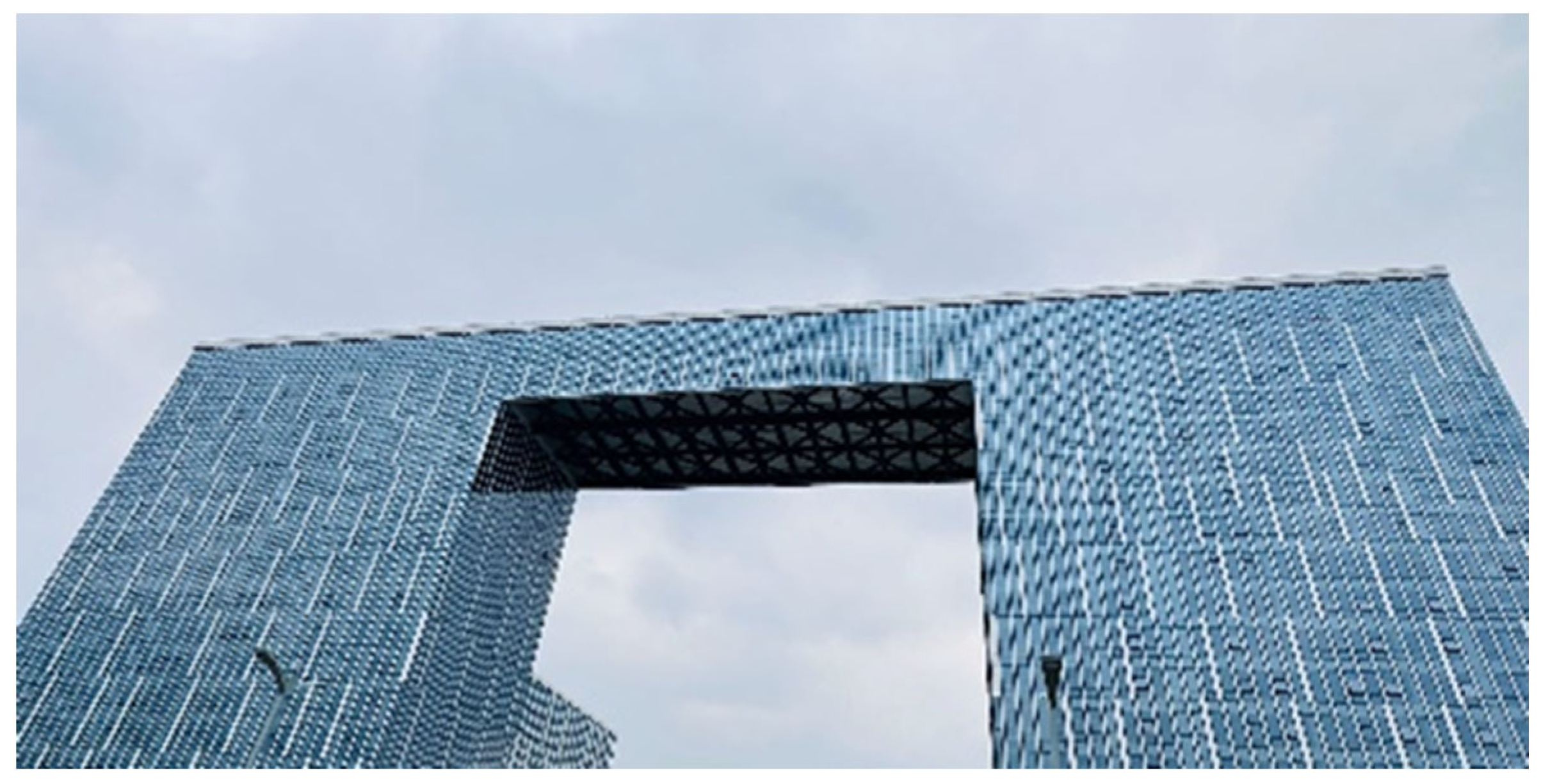
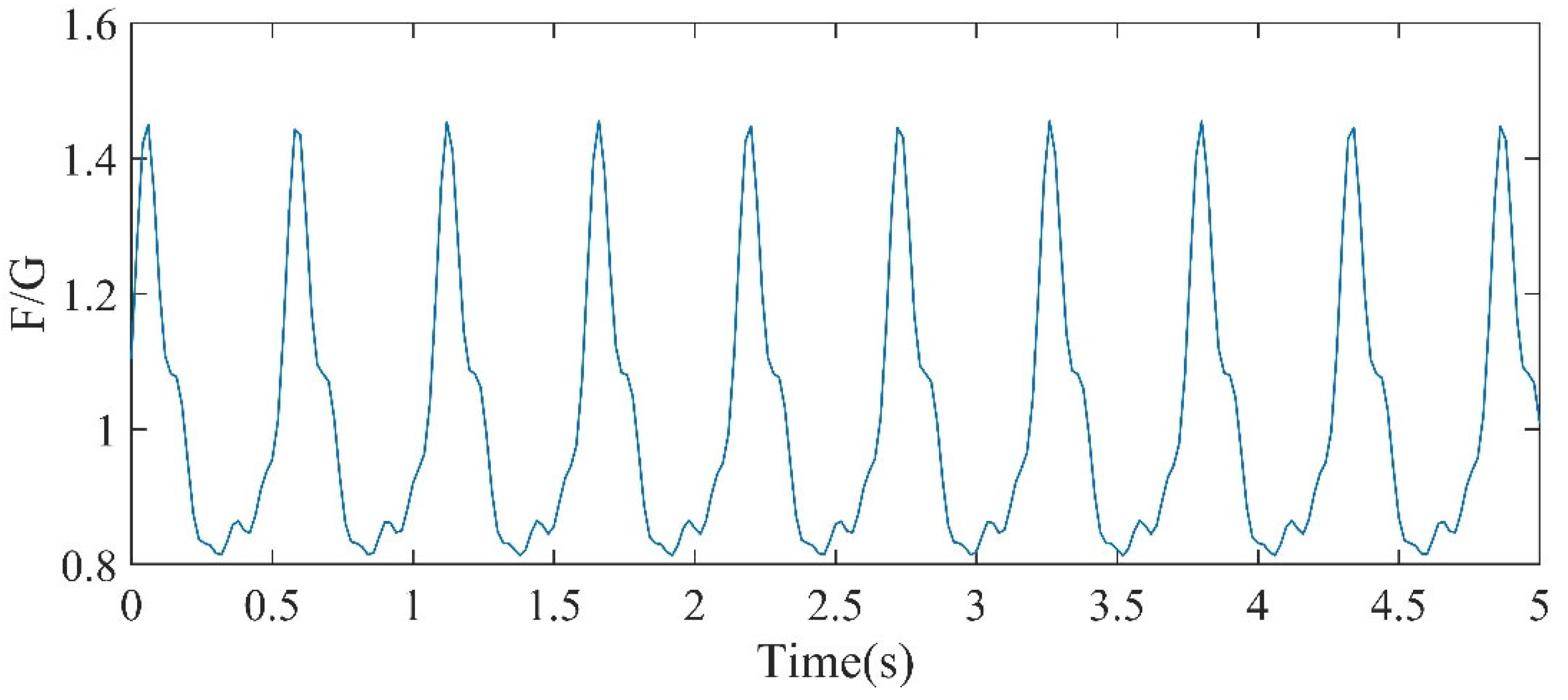




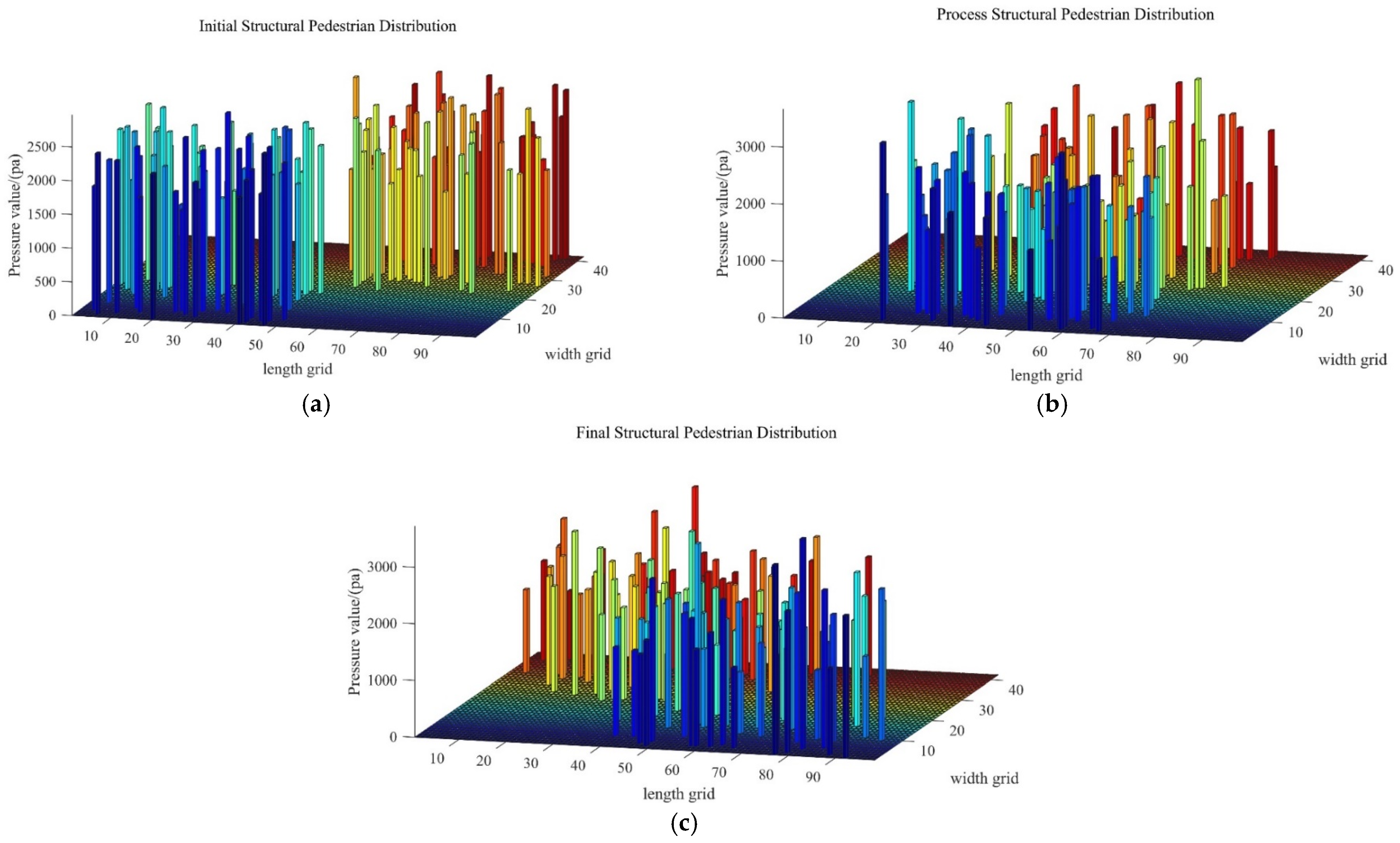
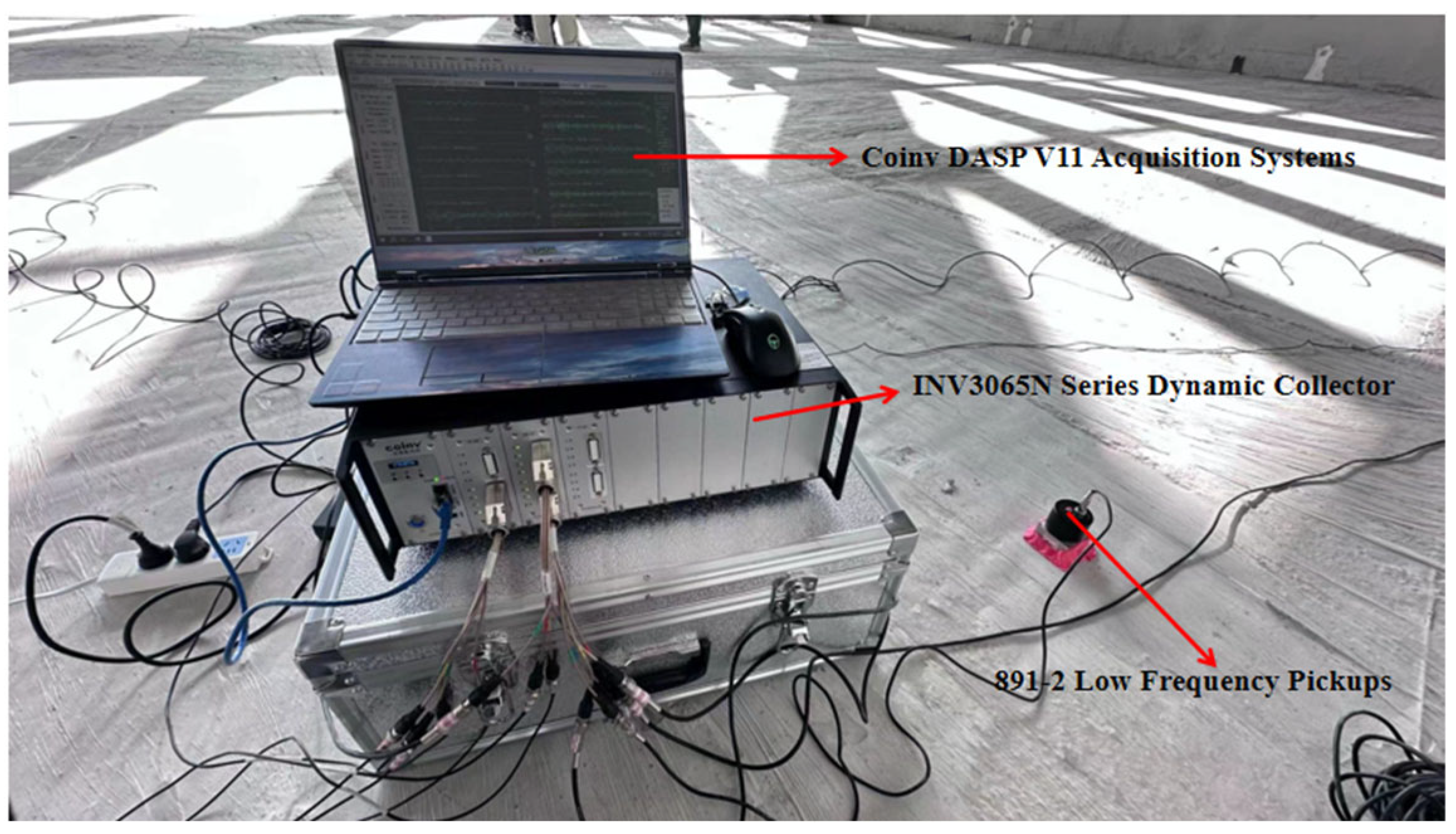





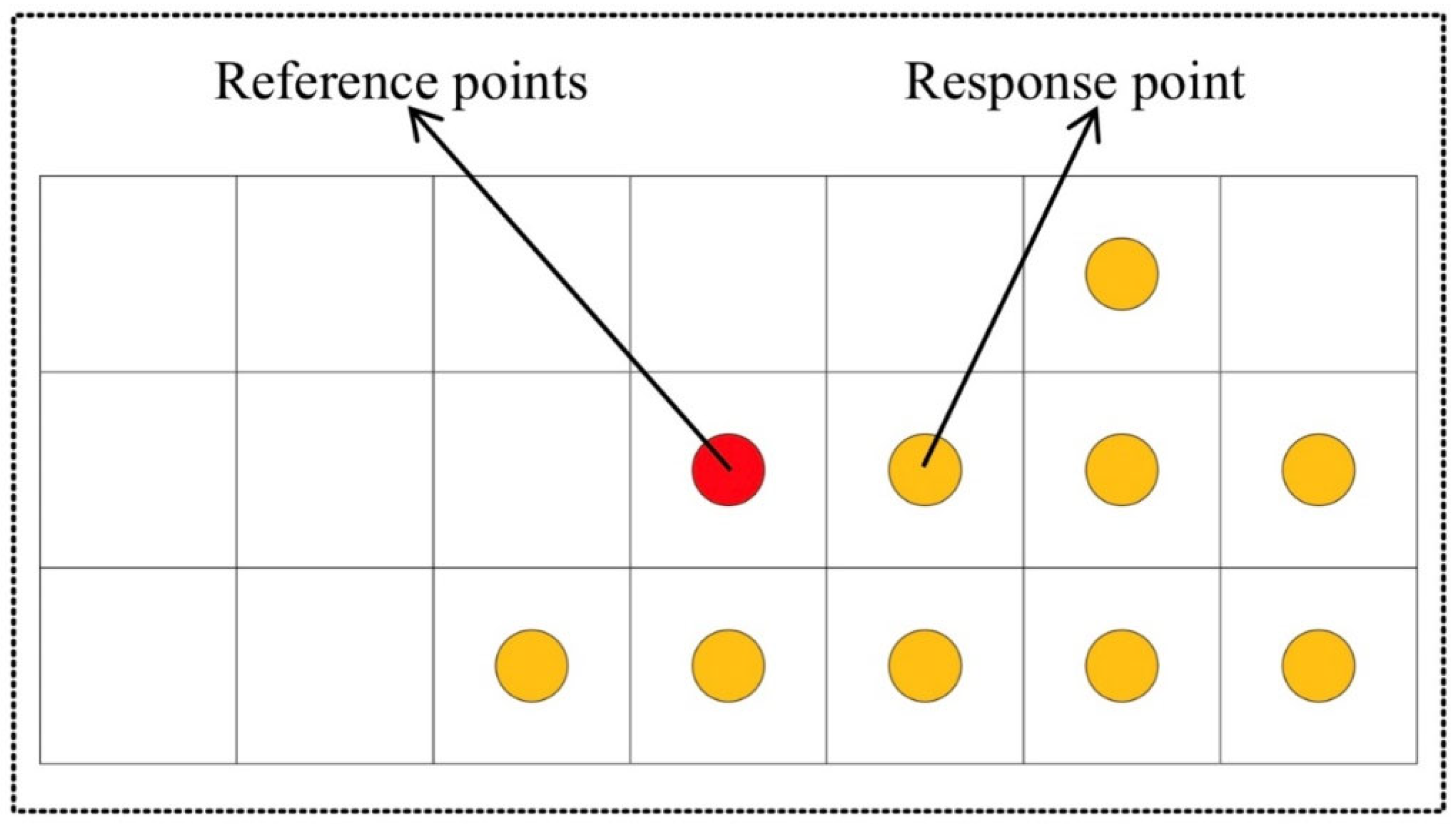

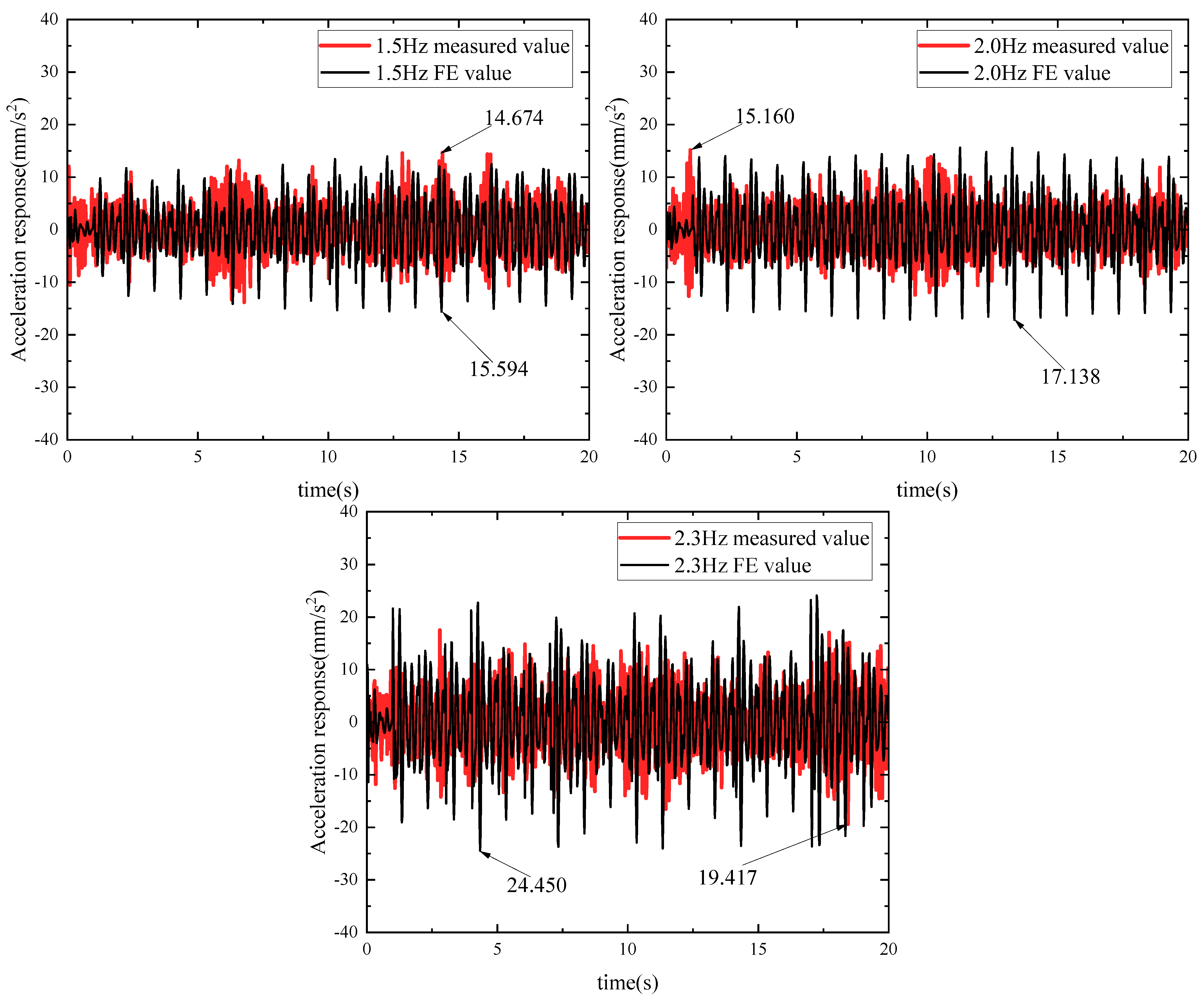
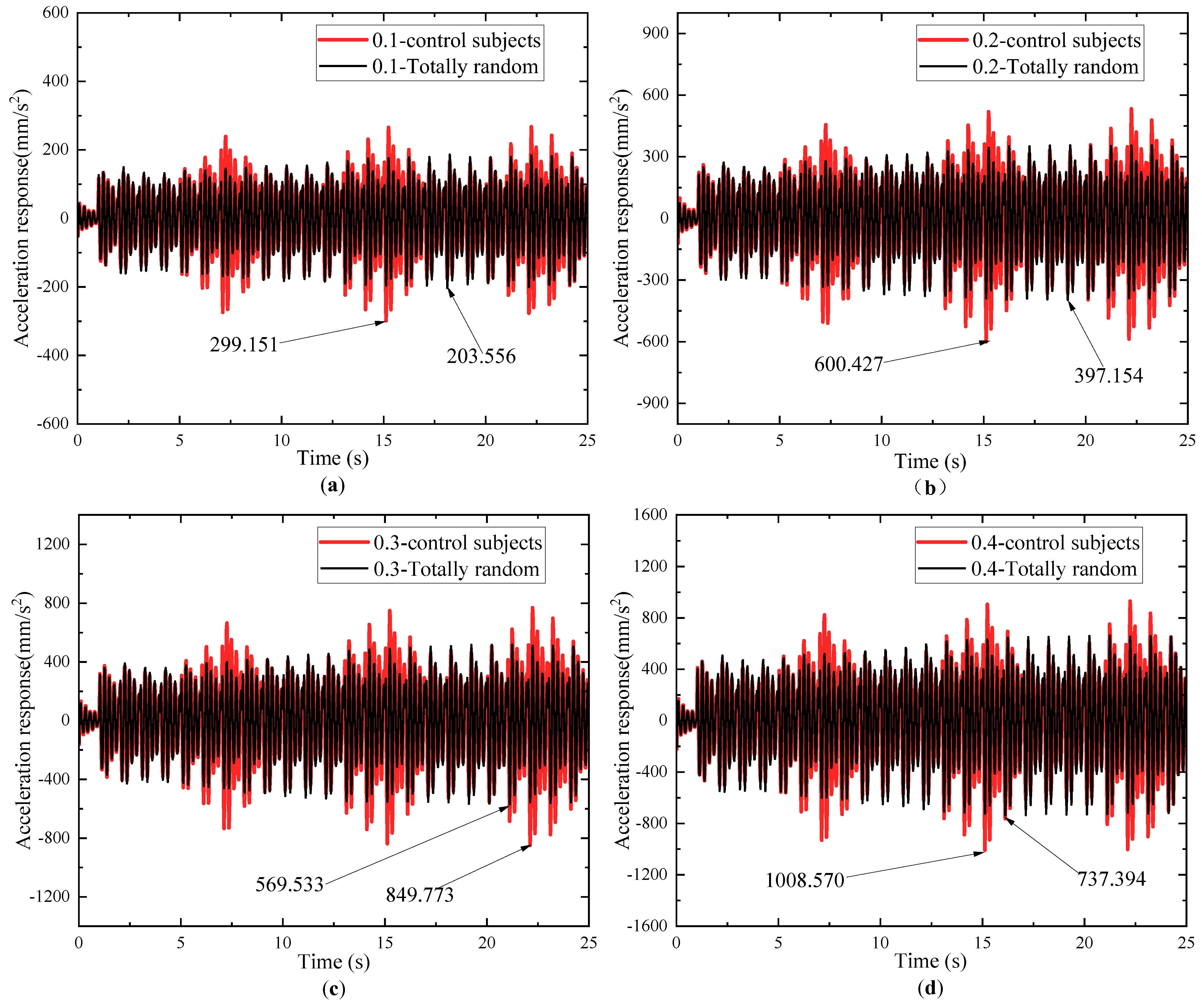

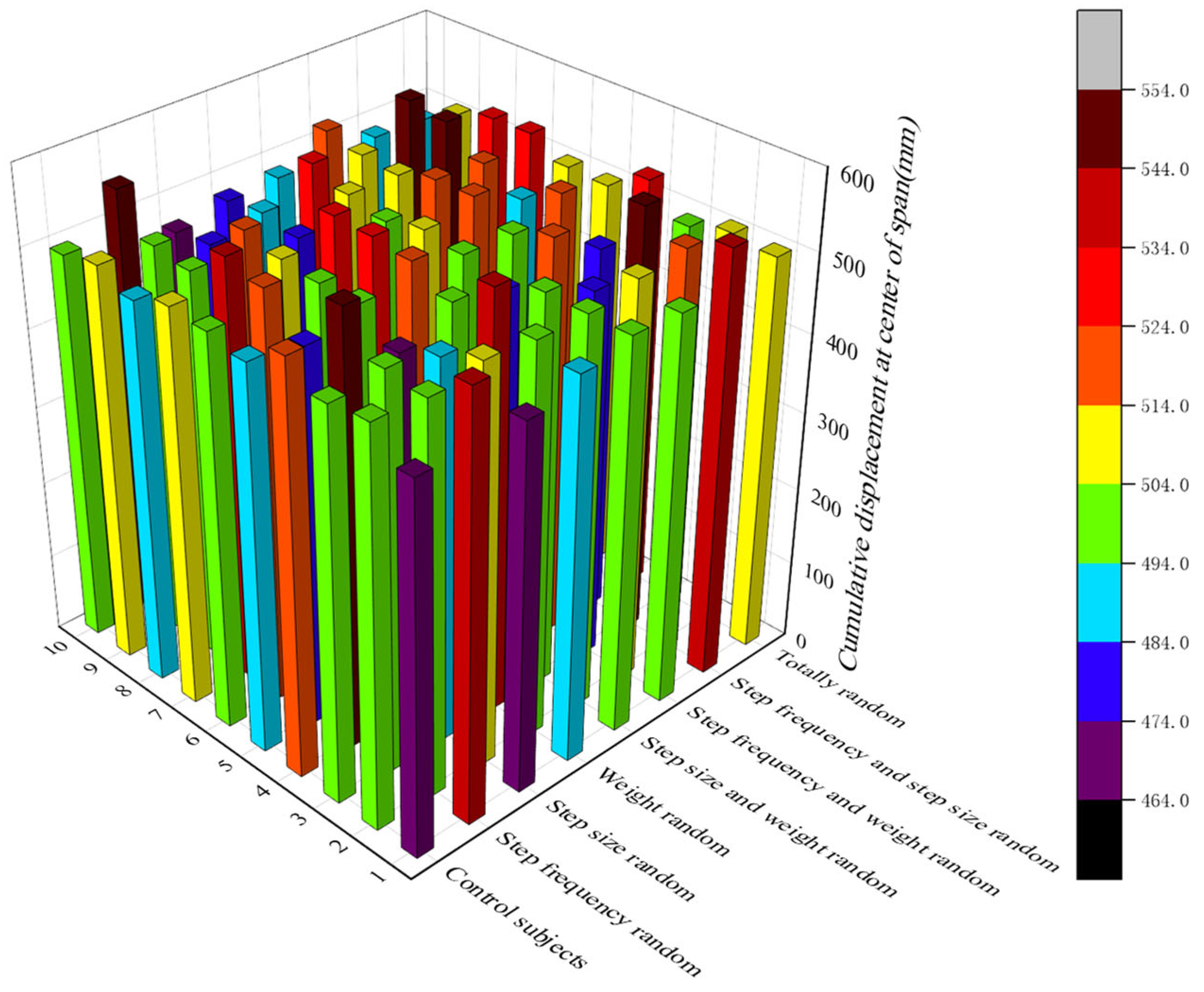
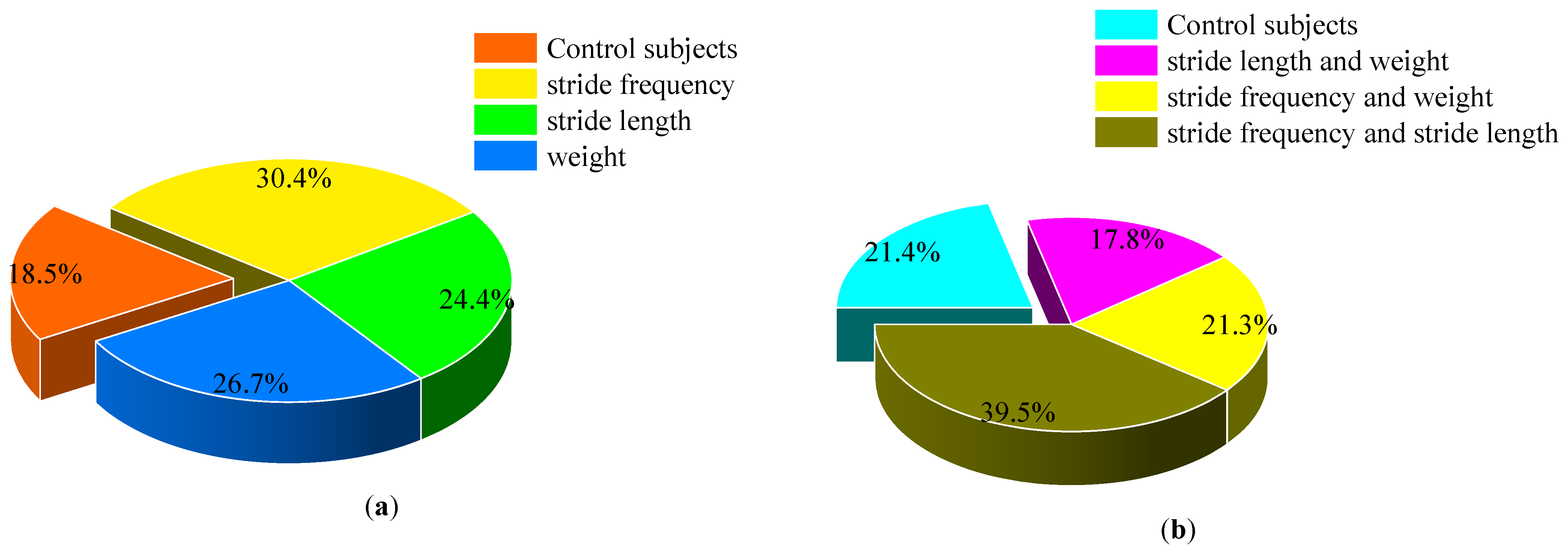

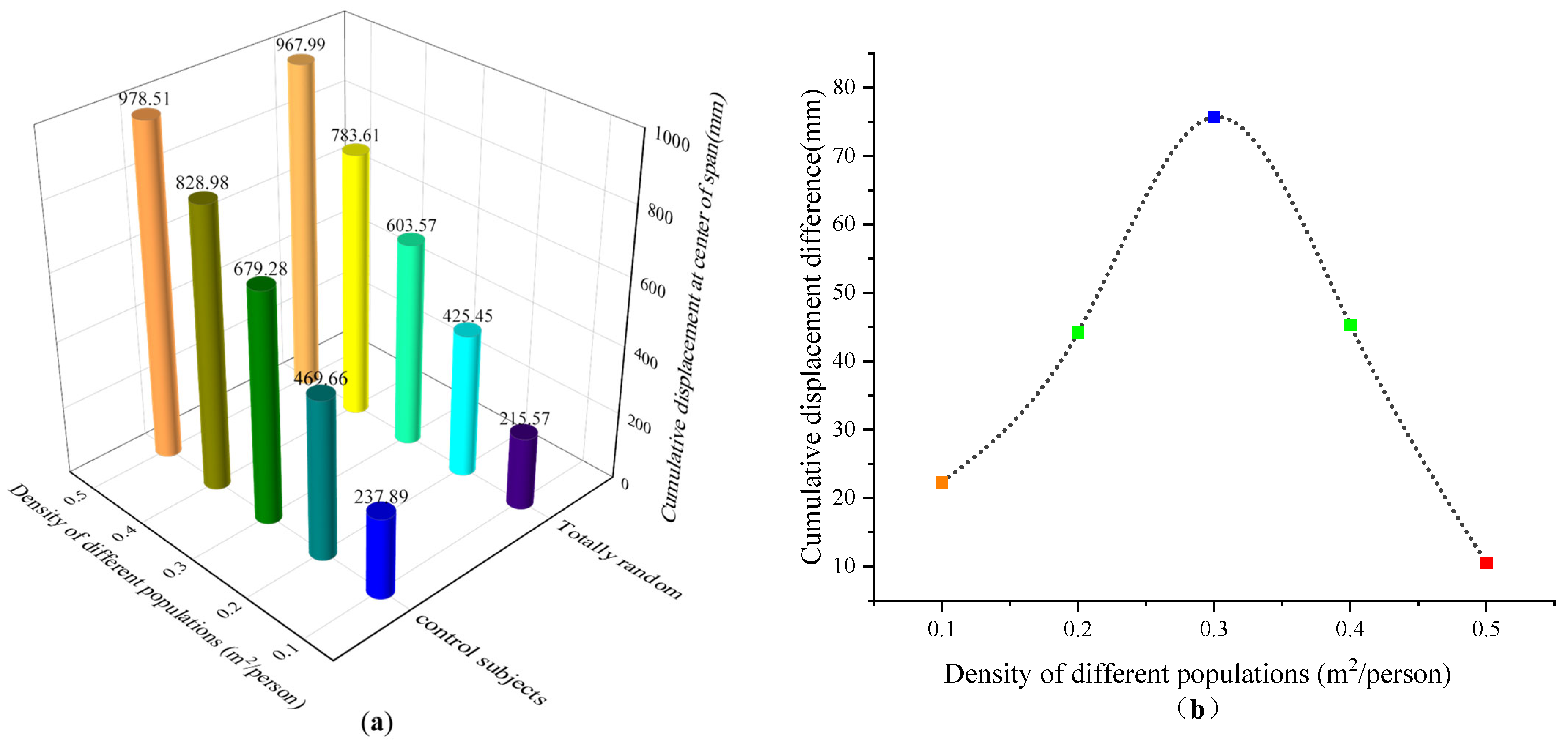
| Walking Parameters | Distribution Type | The Mean | C.O.V |
|---|---|---|---|
| stride frequency [7] | Gaussian distribution | 1.87 Hz | 0.10 |
| stride length [31] | Gaussian distribution | 0.715 m | 0.11 |
| weight [14] | Gaussian distribution | 70 kg | 0.21 |
| Order | Intrinsic Frequency (Hz) | Damping Ratio (%) | Integrated Frequency (Hz) | Integrated Damping Ratio (%) | Modal Damping Ratio (%) |
|---|---|---|---|---|---|
| 1st | 4.657 | 1.237 | 4.657 | 1.237 | 1.3035 |
| 2st | 5.643 | 1.039 | 5.760 | 1.070 | |
| 5.739 | 0.843 | ||||
| 5.898 | 1.328 | ||||
| 3st | 7.531 | 0.705 | 7.731 | 0.711 | |
| 7.677 | 0.621 | ||||
| 7.704 | 0.563 | ||||
| 7.868 | 1.152 | ||||
| 7.875 | 0.514 | ||||
| 4st | 8.291 | 1.331 | 8.529 | 1.537 | |
| 8.302 | 1.608 | ||||
| 8.310 | 1.526 | ||||
| 8.568 | 1.539 | ||||
| 8.585 | 1.509 | ||||
| 8.596 | 1.597 | ||||
| 8.685 | 1.680 | ||||
| 8.703 | 1.489 | ||||
| 8.718 | 1.554 | ||||
| 5st | 9.311 | 1.457 | 9.799 | 1.629 | |
| 9.849 | 1.535 | ||||
| 9.923 | 1.734 | ||||
| 9.933 | 1.667 | ||||
| 9.981 | 1.753 |
| Material | Modulus of Elasticity (pa) | Poisson’s Ratio | Density (kg/m3) |
|---|---|---|---|
| Q355C steel | 2.1 × 1011 | 0.3 | 7850 |
| C30 concrete | 3.0 × 1010 | 0.2 | 2550 |
| Order | Calculated Frequency of FE | Measured Integrated Frequency | Inaccuracies (%) | Measuring Integrated Damping Ratio (%) |
|---|---|---|---|---|
| 1st | 4.590 Hz | 4.657 Hz | −1.439 | 1.237 |
| 2st | 5.730 Hz | 5.760 Hz | −0.521 | 1.070 |
| 3st | 7.622 Hz | 7.731 Hz | −1.410 | 0.711 |
| Tester | 1 | 2 | 3 | 4 | 5 | 6 | 7 | 8 | 9 | 10 | 11 | 12 | Mean |
|---|---|---|---|---|---|---|---|---|---|---|---|---|---|
| stride length (m) | 0.60 | 0.52 | 0.55 | 0.52 | 0.57 | 0.54 | 0.55 | 0.56 | 0.58 | 0.58 | 0.61 | 0.65 | 0.5692 |
| Weight (kg) | 75 | 72.5 | 102 | 70 | 70 | 55 | 70 | 75 | 75 | 100 | 75 | 96.5 | 78 |
| Test Conditions | Number of People | Number of Tests | Stride Frequency (Hz) | Walking Route |
|---|---|---|---|---|
| 1 | 12 | 3 | 1.5/2.0/2.3 | deterministic |
| 2 | 12 | 3 | 1.5/2.0/2.3 | random |
| Stride Frequency (Hz) | Test Conditions | Peak Acceleration (mm/s2) | Comparison Error (%) | |
|---|---|---|---|---|
| Measured Data | FE Calculation | |||
| 1.5 | 1 | 15.081 | 16.284 | −7.388 |
| 2 | 14.674 | 15.594 | −5.900 | |
| 2.0 | 1 | 17.332 | 18.961 | −8.591 |
| 2 | 15.160 | 17.138 | −11.542 | |
| 2.3 | 1 | 21.461 | 26.019 | −17.518 |
| 2 | 19.417 | 24.450 | −20.585 | |
| Max acceleration | 1 | 21.461 | 26.019 | \ |
| 2 | 19.417 | 24.450 | ||
| Comfort Levels | Evaluation of Comfort | Vertical Acceleration (mm/s2) | Horizontal Acceleration (mm/s2) |
|---|---|---|---|
| CL1 | Best | <500 | <100 |
| CL2 | Medium | 500~1000 | 100~300 |
| CL3 | Minimal | 1000~2500 | 300~800 |
| CL4 | Unacceptable | >2500 | >800 |
| Crowd Density (Person/m2) | Condition | Mass Ratio * (%) | Walking Parameters | Peak Acceleration (mm/s2) | Evaluation of Comfort |
|---|---|---|---|---|---|
| 0.1 | Totally random | 0.62 | Gaussian | 203.556 | Best |
| Control subjects | The mean | 299.151 | Best | ||
| 0.2 | Totally random | 1.24 | Gaussian | 397.154 | Best |
| Control subjects | The mean | 600.427 | Medium | ||
| 0.3 | Totally random | 1.85 | Gaussian | 569.553 | Medium |
| Control subjects | The mean | 849.773 | Medium | ||
| 0.4 | Totally random | 2.47 | Gaussian | 737.394 | Medium |
| Control subjects | The mean | 1008.570 | Minimal | ||
| 0.5 | Totally random | 3.09 | Gaussian | 891.144 | Medium |
| Control subjects | The mean | 1201.033 | Minimal | ||
| 0.6 | Totally random | 3.71 | Gaussian | 1095.551 | Minimal |
| Control subjects | The mean | 1420.555 | Minimal |
| Random Conditions | Walking Parameters | Option | Mean (mm) | Standard Deviation (mm) | C.O.V (%) |
|---|---|---|---|---|---|
| Control subjects | stride frequency | Mean | 497.55 | 14.51 | 2.92 |
| stride length | Mean | ||||
| weight | Mean | ||||
| stride frequency | stride frequency | Gaussian | 516.78 | 24.76 | 4.79 |
| stride length | Mean | ||||
| weight | Mean | ||||
| stride length | stride frequency | Mean | 488.94 | 18.83 | 3.85 |
| stride length | Gaussian | ||||
| weight | Mean | ||||
| weight | stride frequency | Mean | 504.76 | 21.32 | 4.22 |
| stride length | Mean | ||||
| weight | Gaussian | ||||
| stride length and weight | stride frequency | Mean | 500.42 | 12.22 | 2.44 |
| stride length | Gaussian | ||||
| weight | Gaussian | ||||
| stride frequency and weight | stride frequency | Gaussian | 507.61 | 14.78 | 2.91 |
| stride length | Mean | ||||
| weight | Gaussian | ||||
| stride frequency and stride length | stride frequency | Gaussian | 520.46 | 28.13 | 5.40 |
| stride length | Gaussian | ||||
| weight | Mean | ||||
| Totally random | stride frequency | Gaussian | 511.05 | 14.70 | 2.88 |
| stride length | Gaussian | ||||
| weight | Gaussian |
Disclaimer/Publisher’s Note: The statements, opinions and data contained in all publications are solely those of the individual author(s) and contributor(s) and not of MDPI and/or the editor(s). MDPI and/or the editor(s) disclaim responsibility for any injury to people or property resulting from any ideas, methods, instructions or products referred to in the content. |
© 2024 by the authors. Licensee MDPI, Basel, Switzerland. This article is an open access article distributed under the terms and conditions of the Creative Commons Attribution (CC BY) license (https://creativecommons.org/licenses/by/4.0/).
Share and Cite
Yang, S.; Wang, G.; Xu, Q.; He, J.; Yang, M.; Su, C. Dynamic Response Study of Space Large-Span Structure under Stochastic Crowd-Loading Excitation. Buildings 2024, 14, 1203. https://doi.org/10.3390/buildings14051203
Yang S, Wang G, Xu Q, He J, Yang M, Su C. Dynamic Response Study of Space Large-Span Structure under Stochastic Crowd-Loading Excitation. Buildings. 2024; 14(5):1203. https://doi.org/10.3390/buildings14051203
Chicago/Turabian StyleYang, Shuwang, Gang Wang, Qiang Xu, Junfu He, Minghao Yang, and Chenhao Su. 2024. "Dynamic Response Study of Space Large-Span Structure under Stochastic Crowd-Loading Excitation" Buildings 14, no. 5: 1203. https://doi.org/10.3390/buildings14051203




